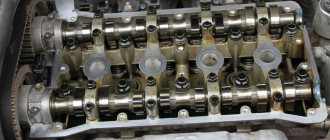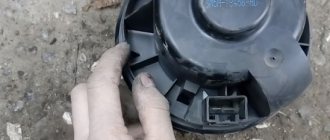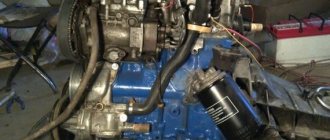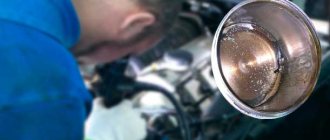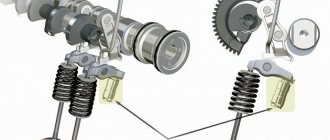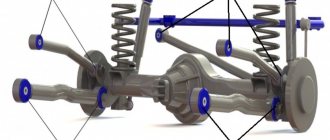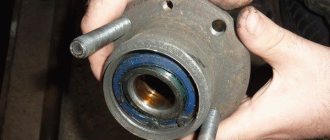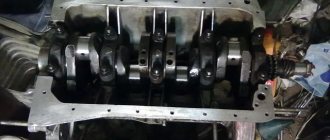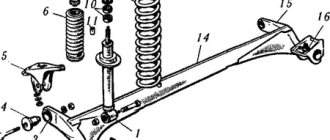Rear suspension design
In order to determine what could be knocking in the suspension, you should know what this element of the car consists of.
- Guide structure.
- Twisted coil springs.
- Shock absorbers.
- Rubber bushings and mounting cups.
A sound in the rear suspension may appear when one of the above elements fails. At the same time, we note that if there is a constant knocking, it is imperative to carry out diagnostics of the suspension. If working with a car causes many problems, then you can entrust the diagnostics to specialists from a car service center. Note that the rear suspension has a very simple design and you can dismantle the worn part yourself.
Possible causes not related to suspension
Before determining what might be knocking, you should make sure that there is a problem with the suspension. Often, a knock may appear due to a minor malfunction of another element, but with strong vibration on the road, it seems that the problem is with the chassis elements. Possible causes of knocking include the following:
- The exhaust pipe in most cases becomes the cause of the knocking, as its fastening wears out over time.
- poorly secured items in the cabin or luggage compartment. You need to check the contents of the trunk, especially the mounting of the spare wheel. If during the first inspection no obvious problems are identified, we proceed to diagnosing the suspension.
Why is a car service better and more convenient?
Any mechanism needs maintenance; the presence of rubbing parts implies the inevitability of wear, so you should not be afraid of knocking in the suspension. This is truly inevitable and eliminating the causes of extraneous noise is part of normal vehicle maintenance. If you do not have repair skills, do not try to eliminate the cause of the knocking yourself. And especially do not resort to the services of yard craftsmen. Their efforts may cost you unreasonably dearly. In a good car service center, professionals will take serious care of your car and you will have the guarantee that the work is done conscientiously and the components are reliable.
Diagnostics of suspension guides
Many cars have a similar rear suspension design, which makes diagnostics and dismantling easier. The differences can only be in the principle of fastening and the type of installed parts. During the diagnosis you should:
- We check the force of the beam, if there are levers. As a rule, due to severe wear, cracks appear, which cause deformation.
- If the hinges are too worn, they can also cause a knocking noise from the rear. Cracks may appear on the hinges, which cause their deformation.
The threaded connection of the flanges used when attaching the guide elements can also cause a problem. The flanges can be repaired, but it is recommended to install new ones. The check is carried out on an overpass or pit, since problems are determined visually or using force (that is, you need to strongly loosen the guide elements with your hands). This will require good lighting. Therefore, it is recommended to carry out work in the garage.
What else could be knocking in the back of the car?
There are the most unusual types of knocking noises that many drivers have been looking for for years and cannot find. If the suspension knocks, the knock sooner or later begins to intensify and localizes itself. That is, you will soon be able to understand where exactly the car is knocking. But if the knocking is monotonous and does not change, there is a real point in carrying out additional checks. These checks consist of discarding the most incredible options for knocking in the rear of the car:
- the wheel has come loose - this is possible after contacting a low-quality tire service; if the wheel is not tightened, it can not only knock, but also fly off at speed;
- There are several metal parts lying in the trunk and actively knocking against each other, but it seems to you that we are talking about knocking directly in the chassis or other systems;
- the spare tire is knocking on a specially designated place for it - place rubber bands under it or simply turn it over, this will help eliminate the knocking, if any, in this unit;
- body parts may knock, if the spot welding has failed or any bolts securing body elements have become loose, the knocking may be annoying;
- The muffler often breaks off the rubber bands and begins to drum on the bottom of the car or the gas tank; this can be easily checked by driving the car into a pit and pulling the muffler in different directions.
All these seemingly incredible aspects are checked first at professional service stations. In 20% of situations, diagnostics of the rear chassis will not even be required - the problems will be eliminated in exactly this way. It is enough just to perform a normal search for the cause of the problem and get more information on how to cope with the tasks. However, it is better to find out this from the specialist after discovering problems. We offer a video with detailed diagnostics of the Hyundai Solaris rear suspension:
Spring problem
Although springs are very durable, they can also wear out over time under certain operating conditions. Often, spring wear manifests itself in a slightly different way: the car wobbles at high speed, strong rocking, or a sagging rear end. However, when looking for something that may be knocking, you can conduct a visual inspection and pay attention to the following points:
- Do the turns have any defects?
- Are the rubber pads intact?
In most cases, springs lose their elasticity due to long service life or when exposed to heavy loads (for example, a passenger car has been used for a long time to transport a heavy load). The appearance of defects in the turns indicates poor quality of the metal used in manufacturing, a manufacturing defect, or severe wear. If everything is in order, we carry out further inspection.
Shock absorbers: a common problem caused by rough roads.
Shock absorbers can be considered the most vulnerable structural element. They are designed to absorb impacts when overcoming broken sections of the road. You can determine shock absorber wear as follows:
- Visually - if a clear oil leak appears, as indicated by oil stains, this structural element must be replaced or repaired.
- Completely disassemble the shock absorber. To do this it is necessary to dismantle them. There are rubber bushings inside the shock absorber that often fail. The problem with shock absorbers manifests itself when overcoming bumps. There may also be poor vehicle stability when driving at high speed. It is worth considering that the method is only suitable for serviced shock absorbers.
Consequences of ignoring a knock
Any extraneous sounds that appear while driving must be identified without delay, as their presence may indicate a serious malfunction. In this case, let’s look at the consequences of knocking in the rear suspension:
- If problems arise in the guides and are not resolved in a timely manner, in addition to material costs, controllability may deteriorate; in some cases, this malfunction leads to a situation where the suspension is secured only by a spring and a shock absorber. The result is wear and tear of all elements, creating an emergency situation.
- If the spring is damaged, the car sways on uneven roads. In addition, the spring does not limit the movement of the shock absorber. The result of spring wear is terrible stability of the car on the road and damage to other suspension elements.
- Failure of shock absorbers is accompanied by a constant knocking sound. As a result, severe wear occurs on the fastening elements, as well as the shock absorbers themselves. In this case, controllability deteriorates significantly, and strong roll is possible when turning at high speed.
In most cases, a knock in the rear suspension is detected almost immediately, as it occurs while overcoming a bump or pothole on the road. As a rule, suspension elements fail after their service life has expired. If you replace parts in a timely manner, you can avoid road accidents and serious material costs.
Other reasons
If diagnostics have been started and no obvious problems have been identified, you can pay attention to the following:
- A brake caliper is an element of the brake system, which, when the pedal is pressed under the influence of the created pressure in the brake hydraulic system (mechanical and electronic are quite rare), compresses the wearing pads. In some cases, misalignment is possible, due to which the pads will wear unevenly and a knock may appear during braking. You can check the caliper visually, as it should also have no defects.
- The hub or bearings are a common problem that leads to humming and knocking noises while driving. To check, the brake disc or drum must be removed. If installed bearings are severely damaged during dismantling, they spill out or have defects that can be identified visually. The bearing mounting method is pressing. That is why, when it gets wedged, the hub can wear out, as evidenced by the bearing turning. You can determine problems with the hub or bearings without dismantling work, for which you need to slightly rock the wheel to the side.
- Another sign is a loose wheel. Wheel rims need to be balanced.
Diagnostics of the vehicle elements listed above in this paragraph should be carried out periodically, since their failure will lead to brake failure or loss of controllability (there are known cases when the hub bursts due to severe overheating, as a result of which the wheel can jam at speed).
Brake calipers - an exclusive problem
Only in some car models with disc brakes in the rear, the brake calipers become loose or simply play. This is problem number one for all budget cars with rear disc brakes. It is the budget nature of fasteners that often causes parts to fail. It is very interesting that calipers can be an invisible cause of knocking, that is, very difficult to diagnose. You will have to perform the following procedures:
- first, you can try to pull the caliper with your hands while the wheel is installed; perhaps the parts of the mechanism are hitting the disc, everything should be tightly screwed;
- Next, you should remove the wheel and carry out manual diagnostics of all possible fastenings of this unit; you should tug the mechanism with your hands to understand the absence of play;
- the next step should be to disassemble the caliper to determine the loose parts, but doing this without experience is not recommended, as many problems can be found;
- when disassembling, you should pay special attention to the quality of tightening of each module and each bolt, this is what can tell you where the knocking problem lies;
- when reassembling, pay attention to the pads; it is quite possible that they are worn out or deformed, and are simply knocking in the places where they are installed during operation.
These are the types of brake problems that can arise in a modern car. This rarely happens in the absence of unprofessional intervention, but it is quite normal on budget cars. With a drum brake system, everything is much simpler; in this case, not a single mechanism can knock. Unless the entire brake drum fell apart, the pads and other parts flew out. This can only be checked by disassembling the entire mechanism.
Causes of knocking
You may be interested in: Brasa Icecontrol tires: reviews. Brasa Icecontrol: manufacturer, characteristics and recommendations
Even a simple rear suspension has shock absorbers, springs, brackets and silent blocks. There is something to knock. If it knocks quite often, then you need to take a little time to diagnose.

